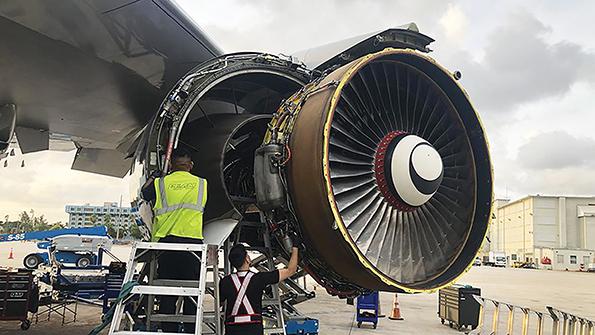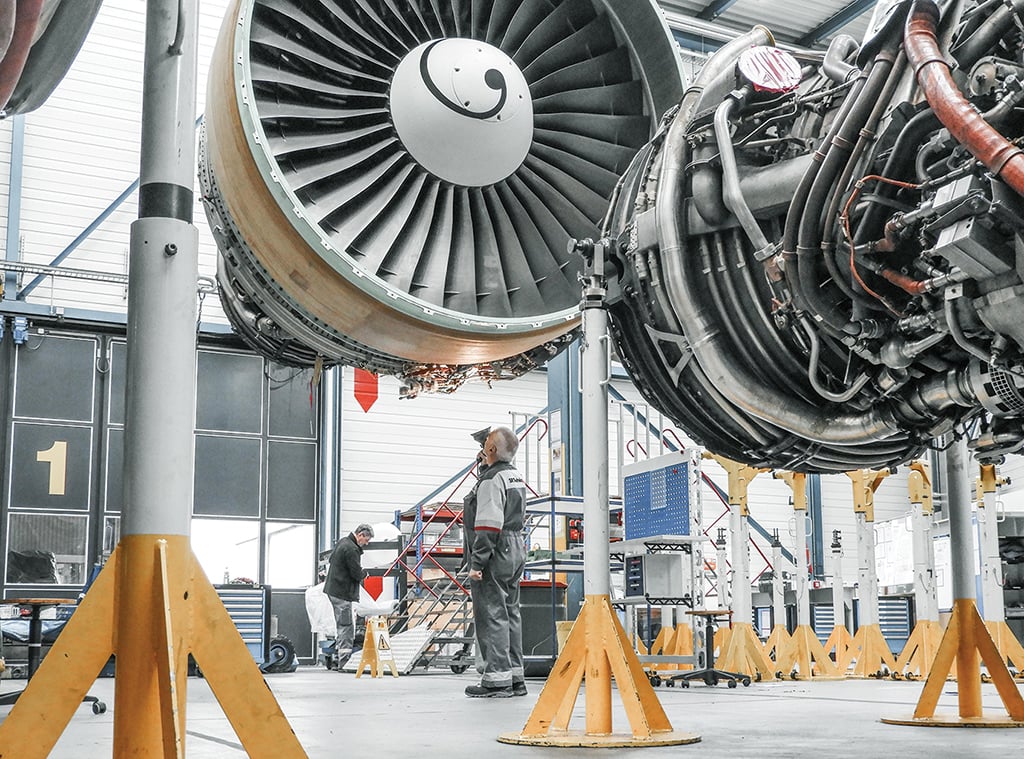
Mobile engine maintenance is one of several repair capabilities that have been in greater demand since the pandemic.
Shop Visit Activity
As global passenger traffic continues to grow this year, engine shop visits are expected to further ascend, with a higher volume of extensive work scopes anticipated. Aviation Week’s Commercial Fleet & MRO Forecast 2023 data projects approximately 7,686 engine overhauls this year. That figure is expected to climb further in 2024 and 2025, to 8,837 and 8,995 shop visits, respectively. In 2023, the same data set values the engine MRO segment at $39.3 billion, accounting for 45% of the whole commercial aftermarket. Engine slot availability remains competitive in North America and Europe.
The return of China’s MRO market has been a boon for MRO providers in the Asia-Pacific region but has inevitably led to fresh concerns about near-term capacity, although several long-term joint ventures are planned to rectify this. Despite engine MROs looking to add capacity to meet surging demand in certain regions, overall global shop visits remain below pre-COVID-19 levels. The industry consensus is that the engine segment will most likely return to pre-COVID levels in the second half of 2024.
Engine Supply Chain Issues Could Be Long-Term
Reduced demand due to the COVID-19 pandemic has led to OEM production constraints. MRO shops have seen engine lead times grow considerably, particularly on new-generation asset types in short supply owing to technical underperformance, sluggish production rates and shortages in areas such as labor. The Russia-Ukraine war has also created shortfalls in raw materials such as steel and titanium that have contributed to the problem.
The rise in shop visit volumes in a segment still playing postpandemic catch-up is putting further stress on the challenged engine MRO supply chain in areas such as parts repair volumes. “Customers are sending more parts out for repair than previously when there were fewer constraints on the supply chain,” says Mike Walsh, president of U.S.-based BP Aero. He attributes this rising demand to several factors, including increasing worldwide shop visits, delays in the supply chain related to slow new parts deliveries from OEMs, MROs reaching capacity and longer lead times at repair shops.
With capacity at a premium, more operators are looking at alternative repair routes away from overhauls and constrained parts markets in the short-to-medium term. Demand for quick-turn and hospital shop services, a popular capability addition in recent years for non-engine specialist MROs, remains robust. Alternatives such as parts manufacturer approval (PMA) parts sourcing and tapping into designated engineering representative (DER) repairs, of which companies are looking to extend the threshold, have also become more attractive. “DER repairs are the necessary evil that we have to deal with until the supply chain and capacity get back to a manageable level,” Anthony Spaulding, president and CEO of Magellan Aviation Group, said in June at Aviation Week’s Engine Leasing, Trading & Finance conference in London.
Remedying Labor Shortages
Airframe manufacturers are looking to rectify the problem by increasing production targets. In turn, engine-makers are addressing capacity concerns through adding engine shop capacity and rebuilding the workforce, which took a substantial hit during the pandemic. At the Paris Air Show in June, CFM International revealed plans to expand its Leap engine support presence to 20 shops by adding Leap Open MRO Network partners.
GE Aerospace expects to hire around 2,000 people this year, while Pratt & Whitney tells Inside MRO it aims to add some 700 new staff to its aftermarket business by year-end after hiring more than 1,400 employees globally last year.

The loss of skilled workers over the past few years has left a void of talent and experience—one that is exacerbating other industry challenges. “Lead times were a problem last year, but this year it’s even more serious because the manpower shortages are still there, but we now see this in the material shortages,” Fulya Turkoz, head of sales for engine services for Europe, Middle East and Africa at Lufthansa Technik, said in June at Aviation Week’s MRO BEER conference in Warsaw, Poland.
Turkoz explained that, especially when trying to recruit younger people, the German MRO provider increasingly considers what it can do to be more appealing while operating in a very traditional industry. “It’s not just about the salary, but giving the freedom and making the working space much more attractive as an industry,” she said.
While hiring the right amount of labor is seen as critical to long-term recovery in the supply chain, there is optimism that turnaround times (TAT) in the engine segment are starting to recover. A representative from Switzerland-based MRO SR Technics sees the supply chain issues and longer TATs resolving in the next 6-12 months, depending on the availability of raw materials and specialized workers.
Meanwhile, Singapore-based ST Engineering is noting improvements in the supply chain compared to 2022 but still sees challenges. “Some OEMs and parts suppliers are still struggling to meet the demands and TAT for repair and overhaul work, and we continue working closely with them to mitigate such challenges,” says Tan Eng Shu, the company’s executive vice president and head of aerospace MRO.
Engine Cost Considerations
Double-digit inflation in some regions has had an inevitable knock-on effect on engine-related costs. Some engine MROs have reported inflation this year of 11-30%.
At MRO BEER, Alan Downey, vice president for customer technical support at lessor Willis Lease Finance Corp., which has 330 engines in its lease pool, said returning demand has driven inflationary costs on the MRO side. “It means that the number of spares that are available at any given time has been reduced, and the TAT in the shops has increased,” he explained. However, Downey does not see this as a wholly negative situation. “It’s typical that we would see inflation in some ways as being a good thing and that it’s showing that our very cyclic industry is now on the upside,” he noted. “This is a good thing in general, even if we are seeing that it has a huge impact on our costs of maintenance.”
New ways for MROs and airlines to work together have evolved as previous strategies of buying material with the expectation that supply chain impacts would be short-lived have not panned out. For instance, a previous strategy of airlines and MROs buying materials directly from OEMs is not proving as cost-effective as before. This has led to a spike in demand for used serviceable materials while engine part-outs aimed at feeding market stock have increased demand for specific assets.
“Something we have noticed recently that is definitely a win-win scenario is when airlines working with MROs open up their books with shop visit planning so that they can work together and do some strategic purchasing in order to take on all these [supply chain] issues,” says Alistair Dibisceglia, director at Oliver Wyman CAVOK.
SAF Focus Expected To Grow
Sustainability is a key driver of technology in the engine segment as the industry strives toward net-zero emissions targets by 2050. In the aftermarket, this has been achieved in the near term by cutting down on waste as MROs switch to paperless operations. The utilization of remote, virtual engine borescope inspections has also picked up speed since COVID-19 as working remotely becomes more widespread.
Several high-profile sustainable aviation fuel (SAF) engine projects involving OEMs, MROs and airlines have emerged in recent years. Industry consensus is that SAF is in its infancy both in terms of development and commercial use, while long-term concerns exist in some quarters about the supply of fuel feedstock.
Rolls-Royce is among the engine manufacturers developing SAF blends for use in powerplants, having undertaken a series of tests across its business units over the past few years. “By the end of this year, we’d have demonstrated that all of our Trent engines are fully capable of flying on SAF,” said Iain Dudley, head of marketing for Trent XWB engines at Rolls-Royce, speaking about emerging technologies at MRO BEER. He predicts zero emissions as the next step for Rolls, followed by zero-emissions flight through the use of hybrid, electric and hydrogen propulsion.





